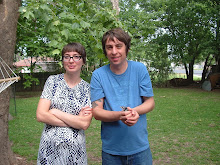
The all too short Spring Garden is always my favorite in Austin. Waiting in anticipation for the first rose bud, the first poppy bloom, the first fig leaflet- and just as the fig tree has fully leafed out- it's time for the grueling Texas heat. We prepared for Summer this year. We installed wonderful rain barrels from Austin Green Water. So far- in this El Nino Spring, I can't use the water fast enough!
The transition from Winter to Spring is always a tricky one at my house. The garden spaces are strategically positioned between 50 year old Sycamores and a lone giant Pecan tree. No garden plot receives full sun. The North Garden is home to the Sun Lovers - Tomatoes, Peppers, Cucumbers, and Summer flowers. Not a drop of Winter Sun reaches the North Garden's soil, thanks to my house casting shadow during the Sun's low Zenith. Plants often get a slow start here. My new Bailey's Red Rose is currently getting only a few hours of morning sun before the house and the large Sycamore shadow it. So far, the Bailey's red Rose has had only two blooms- but that will change as the Sun reaches higher in the sky.
California Poppy
The West Garden, or Backyard Garden, or Winter Garden is home to Winter and Spring Greens- Arugula, Kale, Chard, and Herbs. For about two months, February and March, this garden gets wonderful Sun and the Greens burst forth with crazy tidings. In April, the three 40+ ft trees encircling the little garden start to leaf out- stealing the garden's show.

Arugula Blooms
The most prominent species in the Spring Garden is the beautiful 'crop cover' Hairy Vetch. I planted the Hairy Vetch early last spring with a Vetch inoculant and let the lovely flowers go to seed. Well, it reseeded itself and puts on another lovely- yet wild and a bit overgrown show this year. The bees absolutely love it and so do the night time pollinators- moths and the like.
Bee on Hairy Vetch
You cannot go wrong with this plant. It's a nitrogen fixer if inoculated, a pollinator feeder, it puts on a show of delicate blooms that lasts for a few months, and is a great mulch for the incoming tomatoes!
Hairy Vetch
I plant my tomatoes and peppers right in the Vetch. I clear a spot large enough for the transplant and am sure to use a tomato cage for peppers and tomatoes alike- that way I am sure to not loose them in the Vetch. There is a little Vetch maintenance involved with this method- the Vetch tendrils tend to affix themselves to anything- especially tomato cages.

Tomato in Vetch
I love the Vetch even though it is a bit invasive and needs to encroach on another's space. The Vetch spills over the sides of the raised beds, onto the ground, and into the neighboring raised bed a foot and a half away. In the picture below, it looks as if the Yarrow and Vetch are planted in the same bed. I don't mind this temporary invasion- once the short Austin Spring warms to near Summer temperatures, the Vetch will turn to seed and it's tendrils and leaves will wilt into a thin layer of mulch until next year.
Vetch over taking Yarrow





